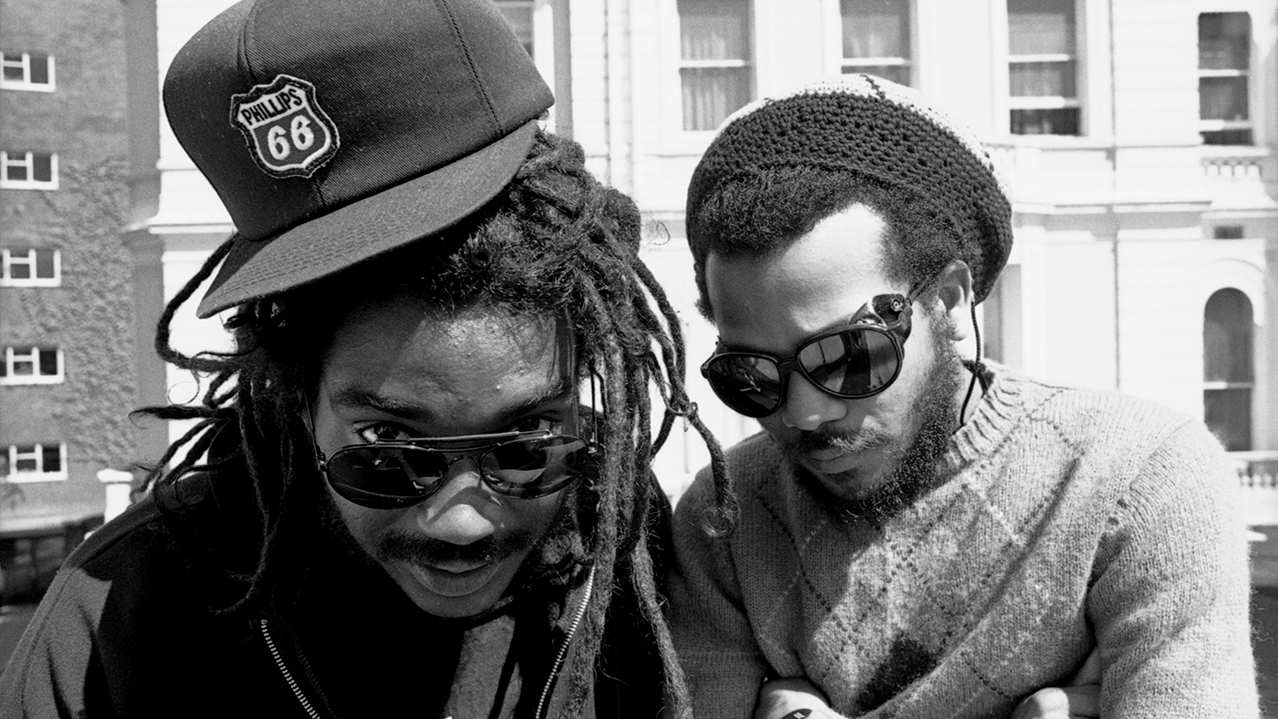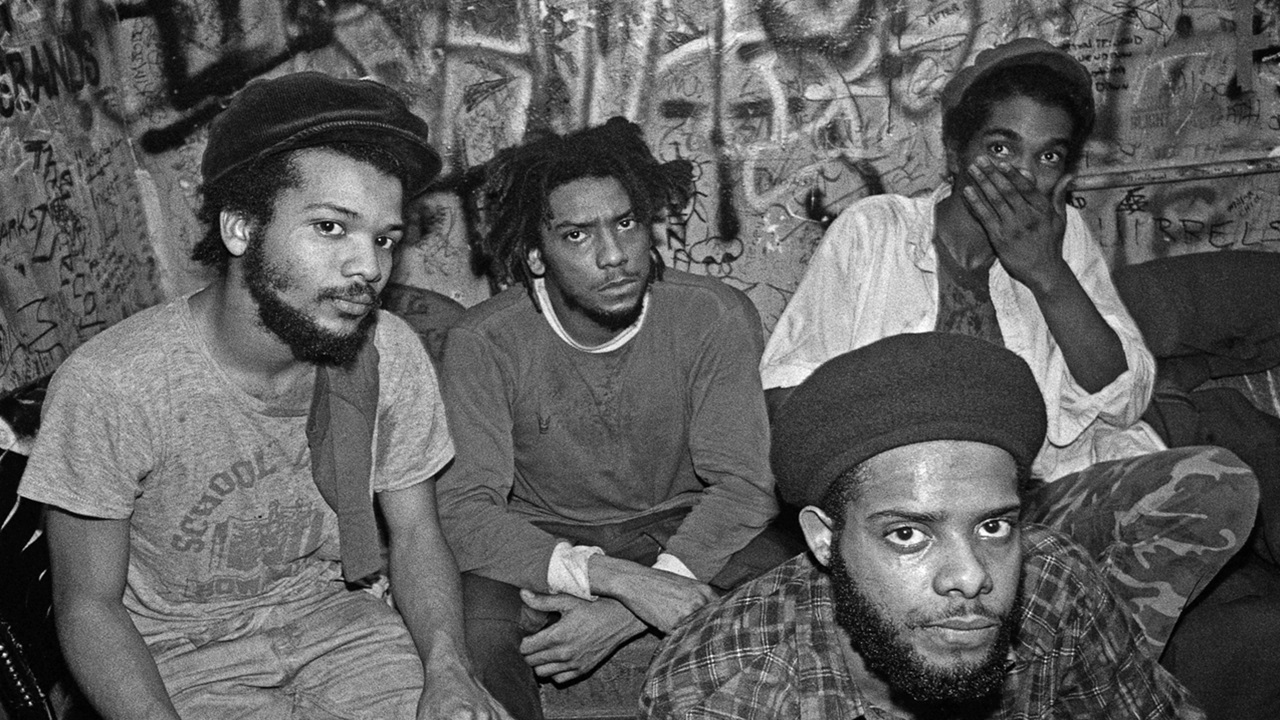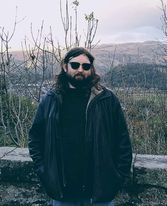There’s footage on YouTube of Bad Brains playing fabled New York punk dive CBGBs in 1982, and it looks like bedlam being unleashed. The bodies of crowd members fly back and forth as, somewhere in this frantic tide of flesh, the band are playing like their lives depend on it. Onstage, frontman Paul ‘H.R.’ Hudson exudes a hyperactive energy, his skinny body convulsing and shuddering as he wails and gabbles at turbo speed. Then, just when it looks like it’s going to spill over into violence, everything stops and he begins to croon a reggae tune. Now nobody knows what the hell they’re supposed to do.
This was a typical scene for Bad Brains back then, and their ultra-kinetic live shows set the standard for punk and hardcore gigs in the late 70s/early 80s. They’ve even been credited with inventing a brand new phenomenon: moshing.
“The whole slamming shit… it was pogoing when I started!” says Bad Brains bassist Darryl Jenifer. “All that shit started with us. Because of the speed, I think those kids ended up bouncing into each other instead. Especially when we started adding those reggae parts, and kids were skanking like they’d come to see The Specials.”
Five Black kids from “the wrong side” of Washington DC, Bad Brains took punk rock’s sped-up approach and hypercharged it, helping to kickstart the hardcore movement and change the shape of music. The list of bands and musicians who have cited them as an inspiration is long and diverse: Slayer, Dave Grohl, Beastie Boys, Killswitch Engage, Fever 333, Guns N’ Roses, Clutch… Bad Brains transformed just about anyone who heard their records or saw them live.
“It wasn’t until later in life I realised how lucky I was, having Bad Brains as the local band,” says Clutch vocalist Neil Fallon, who grew up just outside Washington DC. “Like, ‘Everybody has one of these, right?’ No! I remember going to see them when I was 17, getting into the club, and H.R. did this backflip. Then they busted into [classic Bad Brains song] Banned In D.C. and I was just thrown, ejected to the back of the club by sheer force. It was the first time I realised music could be a spiritual energy.”
A conversation with a member of Bad Brains, it turns out, is a lot like listening to Bad Brains. At 63, Darryl Jenifer is still a whirlwind of enthusiastic energy. Speaking to Hammer on the phone, the conversation dips, jumps and sometimes goes wildly off-tangent, only to suddenly race back in at the original point.
He’s thoughtful as he talks about music history, humble whenever the topic of Bad Brains’ own legacy arises, and practically bouncing on the spot whenever musical theory and technique comes up. But then, that’s always been Bad Brains’ secret weapon. They might have been a bunch of punks, but they could play just as well as any 80s shredder or virtuoso. They just happened to do so while inciting absolute anarchy, their songs a thermonuclear detonation of super-speed riffs, whiplash-inducing breaks and joyous, unbridled rebellion.
Starting out as a jazz-rock group called Mind Power in 1976, they changed direction entirely when original vocalist Sid McCray brought records from the Sex Pistols, Ramones and Dead Boys to their attention.
“When I first heard punk rock, I felt two things: that I could be myself, but also that anybody could play,” says Darryl. “It was more about the message and protest. I liked that. Virtuosos don’t impress me, man. It’s the people who really try that impress me.”
Ironically, Sid bailed out of the group when Mind Power changed their name to Bad Brains and began to play punk rock, leaving then-guitarist H.R. (it stood for ‘Human Rights’) to take his place as singer. Their original, and classic, line-up was completed by Darryl, guitarist Dr Know (real name: Gary Miller) and H.R.’s younger brother, drummer Earl Hudson.
H.R.’s hyperactive onstage performances were reflected in the audiences they attracted. Shows grew more chaotic and they were blacklisted from clubs in their hometown, a situation later immortalised in the song Banned In D.C. Their debut single, 1980’s Pay To Cum, captured their anticommercial, anti-conformist ethos (‘I came to know with now dismay / That in this world we all must pay,’ spat H.R.), even if that vivid title had no real meaning beyond provocation.
“It was just a vulgar title,” says Darryl, who came up with it. “I was a Black kid in the hood with the illest fashion - I had a swastika t-shirt thinking I was Sid Vicious! H.R. was older and was reading these books, spawning this real consciousness, so the lyrics ended up becoming something completely different. It was punk rock’s anger and vulgarness being expressed by a Black youth, in a Black community.”
Just as important as punk to Bad Brains was reggae. After seeing Bob Marley live in 1980, the band became invested in Rastafarianism, a religious and political movement centred in Jamaica. They began writing reggae songs, dropping them in as points of calm during the maelstrom of their live shows. By the time they recorded their debut album in 1981, they'd relocated to New York, connecting with the Big Apple’s burgeoning hardcore scene.
“We went down to the Lower East Side where we were staying with [producer] Jerry Williams – or Jay Dublee as we knew him then – and we set up in there,” Darryl recalls. “It was a street thing – real punk rock, real hardcore recording in this dirty ass room. It was real, it was authentic.”
That record – released via cassette-only label ROIR in February 1982, and variously referred to as ‘The Yellow Tape’, ‘The ROIR Sessions’ or simply ‘Bad Brains’ – struck a brilliant balance between the furious hardcore punk of songs such as Attitude and Banned In D.C. and the chilled reggae of Jah Calling and Leaving Babylon.
However, their Rastafarian faith came with problematic elements. The religion takes a less than tolerant view towards homosexuality, and Bad Brains were accused of directing homophobic slurs at gay members of punk band the Big Boys while on tour in Texas in 1982. The song Don’t Blow Bubbles, which appeared on 1989’s Quickness album and suggested that AIDS was God’s punishment for homosexuality, indicated the earlier incident wasn’t a one-off.
The band have subsequently admitted to past prejudices, and distanced themselves from those viewpoints, while Don’t Blow Bubbles was removed from the recent reissues of Quickness.
“No one in the Bad Brains hates gays, we love all God’s children,” Darryl told PunkNews in 2010. While the controversy with the Big Boys took the shine off Bad Brains’ halo, it didn’t derail their career. The band were more than capable of doing that themselves.

The mainstream music industry wasn’t oblivious to Bad Brains’ impact. Major labels’ offers were fielded and roundly rejected, the band furiously protective of their creative freedoms and determined to not be abused by shady record execs. For their second album, 1983’s Rock For Light, they signed to independent label Passport Records, enlisting Ric Ocasek, frontman with new wave chart-botherers The Cars, as producer.
Less raw than its predecessor, Rock For Light showed what Bad Brains were capable of, as they honed their songwriting and became a tighter unit. Unfortunately, any chance Bad Brains had of breaking through to the next level was scuppered by the constant in-fighting, self-sabotage, and superhuman ability to snatch defeat from the jaws of victory, something that would become a depressingly prevalent trend throughout their career.
Rock For Light attracted the attention of Elektra Records, except H.R. was having none of it. He quit the band, followed by his brother Earl. It would be three years before the members of Bad Brains reunited. By then, their legend had expanded beyond the realms of punk – the thrash scene, for one, had taken on their light-speed approach. At the same time, Bad Brains’ own musical direction had changed. Their third album, 1986’s I Against I, added elements of funk, soul and metal to their already unique mix.
“I Against I was way more of a production,” Darryl says. “We weren’t so purely punk rock off the streets because we could get more creative. But the riffs I created for that album, I thought they were commercial! It was me making an attempt at commercial rock radio.”
While I Against I didn’t give Bad Brains the breakthrough they deserved, it did inspire a generation of kids who would go on to form some of metal’s most influential bands, including Sepultura founding brothers Max and Iggor Cavalera, Machine Head’s Robb Flynn, Killswitch Engage’s Jesse Leach and Fever 333 frontman Jason Aalon Butler.
“They were so radical in what they were saying, especially in a very white-dominated genre,” Jason Aalon Butler told Hammer in 2021. “The first time I heard I Against I was at my friend, Paul’s. I was like, ‘Wow, this is crazy!’ Then he told me that they were all Black dudes, and I just thought that was incredible. I remember feeling like I wasn’t alone, and that maybe I wasn’t as much of a freak as the people of Inglewood made me out to be.”
Sadly, Bad Brains’ second coming was short-lived. H.R. and Earl quit the band again in 1987, kicking off a period of line-up instability. The brothers would come and go several times over the next decade – at various points, H.R.’s place was taken by Taj Singleton, former Faith No More singer Chuck Mosley, and Israel Joseph I, the latter of whom appeared on 1993’s Rise album.
The only consistent thing about Bad Brains seemed to be their volatility. With H.R. back in the band, they signed to Madonna’s Maverick label for 1995’s God Of Love album and embarked on an arena tour opening for the Beastie Boys. However, a backstage altercation with their manager before a show in Montreal saw H.R. carted off in handcuffs (no charges were pressed).
At a show in Kansas, H.R. was jailed again after hitting a violent skinhead with his mic stand. This time, however, the band couldn’t post bail. They were dropped from the tour and, shortly afterwards, Maverick. Years later, Darryl Jenifer seethed about the injustice of it. “Every group of our level has this ‘thing’ sort of going on,” he told Classic Rock in 2005. “I really, honestly believe because we’re Black – not to wave any type of racial flag… I always used to say that if Led Zeppelin throw a TV out a window, that’s ‘rock’; the Bad Brains smoke up a room with weed and throw bottles all over, we’re like, ‘n***ers’.”
The last 20 years of Bad Brains’ career has been marginally less chaotic, though not without issues. After 2002’s reggae-focussed I & I Survived album – which featured samples of H.R.’s voice, but not the man himself – the classic line-up reunited for 2007’s Build A Nation, produced by Adam Yauch of the Beastie Boys. 2012’s Into The Future continued in that vein, but to date remains their last record… though rumblings of a follow-up titled Mind Power have surfaced in interviews over the last decade.
H.R. and Dr Know have had to contend with serious health issues, too. In 2013, the singer was diagnosed with schizoaffective disorder, and he has been hospitalised on multiple occasions with severe headaches related to SUNCT syndrome. In 2015, Dr Know suffered a heart attack and was placed on life support, though thankfully he made a full recovery.
Bad Brains have remained largely inactive since 2017, when they played shows with guest vocalist Randy Blythe helping out alongside H.R.. They have also organised a number of benefit shows to support H.R., at various points enlisting members of Living Colour, ska-punk outfit Sublime and former Slayer drummer Dave Lombardo.
Yet for all the turbulence that has surrounded their career, Bad Brains are more influential and relevant today than ever before. Darryl isn’t particularly interested in talking about the artists his band have inspired or the band’s impact on music, though. Instead, he says their biggest legacy is breaking down racial and cultural barriers in alternative music.
“I wanted that unification, man,” he admits. “I’d get that in London, all different kinds of dreads who love to come out and skank to this music that came from Jamaica. I’ve always been down with Rock Against Racism and Crass, Discharge… I’m 63 now, but I’m also still a Black youth that loved all of that.”
The reissue of I Against I is out now via Bad Brains Records/Org Music.



